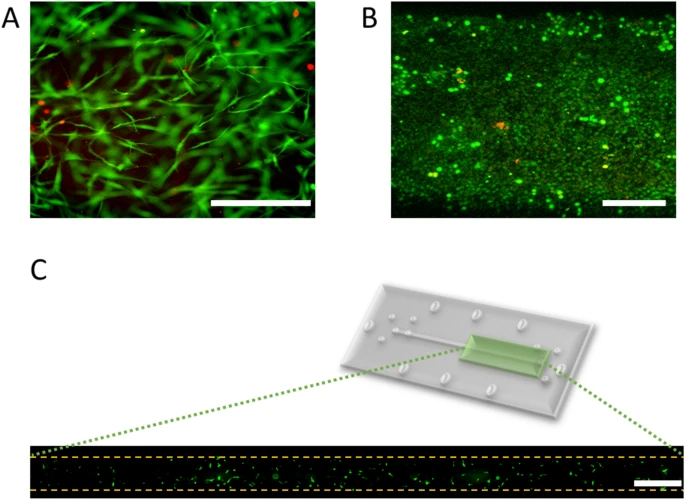Introduction
Every organ is composed of a mesenchymal (stroma) and a parenchymal fraction. Conventional two-dimensional (2D) cultures are often focusing on the mimicking of the parenchymal fraction (eg, hepatocytes, enterocytes, neurons, cardiomyocytes, nephron,…). When moving from 2D to three-dimensional (3D) culture the stroma has also to be taken into consideration and reproduced.
Another fundamental and challenging aspect is to bring vasculature, either under the form of a differentiated endothelium or as a fully forms blood vessel.
The paper published in 2021 by Valencia et al. describes methods to mimick human organ physiology using multi-layered tissue on-chip.
They apply their technology to the skin, creating a tissue-on-chip using skin cells. Such technology can be used in the newly developing field of microphysiological systems for 3D cell culture.

Abstract for Tissue-on-chip using Skin cells
The authors state that “Microfluidic-based tissues-on-chips using skin cells (TOCs) have thus far been restricted to modelling simple epithelia as a single cell layer, but likely due to technical difficulties, no TOCs have been reported to include both an epithelial and a stromal component despite the biological importance of the stroma for the structure and function of human tissues. We present, for the first time, a novel approach to generate 3D multilayer tissue models in microfluidic platforms. As a proof of concept, we modelled skin, including a dermal and an epidermal compartment. To accomplish this, we developed a parallel flow method enabling the deposition of bilayer tissue in the upper chamber, which was subsequently maintained under dynamic nutrient flow conditions through the lower chamber, mimicking the function of a blood vessel. We also designed and built an inexpensive, easy-to-implement, versatile, and robust vinyl-based device that overcomes some of the drawbacks present in PDMS-based chips. Preliminary tests indicate that this biochip will allow the development and maintenance of multilayer tissues, which opens the possibility of better modelling of the complex cell-cell and cell-matrix interactions that exist in and between the epithelium and mesenchyme, allowing for better-grounded tissue modelling and drug screening.”
Source:
Valencia, L., Canalejas-Tejero, V., Clemente, M. et al. A new microfluidic method enabling the generation of multi-layered tissues-on-chips using skin cells as a proof of concept. Sci Rep 11, 13160 (2021). https://doi.org/10.1038/s41598-021-91875-z


